Seizing the Infrastructure Opportunity
| By Gabriela Huerta | 0 Comentarios
Bridges, roads, water systems…these are but a few examples of the infrastructure essential to keep the global economy moving forward. Infrastructure itself demands ongoing investment. In the developed world, the need is for improvement and new capacity; in emerging markets, urbanization and population growth are driving new spending. Indeed, global infrastructure projects are forecast to more than double by 2030.
Such a robust expected growth rate for infrastructure is certainly supported by the current environment. Not only does the need for more spending exist, but, according to Legg Mason, there’s heightened interest for more fiscal stimulus, especially in the developed world, to help boost a lackluster rate of economic growth. Monetary policy initiatives have largely supported the world economy since the financial crisis of 2008, but if fiscal policy begins to play a larger role then infrastructure could be a natural beneficiary.
Infrastructure in the US: The Trump factor
Increased infrastructure spending is certainly a priority for the new Trump Administration in the United States and it’s one of those rare issues that seem to have a lot of bipartisan support, increasing the likelihood that it actually happens. One of the world’s most important proponent of infrastructure investment right now can be seen in President Donald Trump’s well-publicized trillion-dollar spending objective, the details of which however, are not yet known. According to Richard Elmslie, co-CEO and Portfolio Manager at Legg Mason, “In general, what President Trump is really trying to do is, rather than to build a lot of new infrastructures, to rebuild those existing infrastructures that are in poor condition, and this is actually a proposal that carries fewer risks. His vision is exactly how we look at the infrastructure sector.”
Ajay Dayal, Investment Director at Legg Mason added that “when we find opportunities, we apply a highly-disciplined bottom-up process based on risk-adjusted returns; in fact, RARE is the acronym for Risk Adjusted Return on Equity. Opportunities can come from different factors: from profitability factors, political, or changes in the economic outlook,” explains Dayal. As an example, he recalled that just after the US elections, after Trump was elected, bond yields began to rise and many people began to flee from utilities, which the market sees as a proxy asset to public debt. “After a while, these companies became really inexpensive and from our perspective, when there is a generalized exit from this type of stocks, we must study the opportunities that have arisen there in terms of valuations,” he points out. But the question surrounding Trump is whether this is a time to invest in infrastructure because of the plan that could be implemented in the United States, or whether there is something else. Dayal is convinced that this opportunity, in which the private sector will play a very important role in the financing of projects, is going to spread to many more countries. “Trump’s agenda is incredible for attracting infrastructure investments to the United States, and it’s making people realize that the best way to create growth in a country’s economy is through spending in this area. But Trump’s plan is also going to make other developed and emerging countries take a look at it in terms of productivity.
The need for investment capital
While the public sector will remain a major source of financing, greater private sector participation is a must, given fiscal constraints and the sheer magnitude of the need. With greater involvement from the private capital markets the opportunities for investors should naturally increase as well. In fact, the demand for private-sector capital to make ambitious plans a reality creates opportunities for investors looking to participate in this growth, and to participate in the income opportunities which are a unique feature of this type of investment.
Recognizing the income opportunity
For investors, infrastructure offers a potential opportunity to address some of today’s challenges—like the need for competitive income. Indeed, the S&P Global Infrastructure Index, a key benchmark for the sector, sported a dividend yield of 3.75% as of 3/6/17 compared with 2.37% for the MSCI World equity index and just 1.68% for the Bloomberg Barclays Global Aggregate Bond Index.
In some cases infrastructure company revenues are regulated and often linked to inflation. This can provide for stable cash flows and serve as a potential hedge against inflation. Stable cash flows can allow for sustainable dividend payouts and may contribute to lower correlation and less volatility relative other major global asset classes, which can make it a worthy diversifier in a broader portfolio.
Behind the income from infrastructure investments
Infrastructure investments are uniquely appropriate for investors looking for secular growth in the longer term. The listed companies in these sectors can generate stable dividends and have the potential to generate returns at attractive valuation levels. But surprisingly, it’s the regulated nature of the infrastructure companies that accounts for the highly sought-after potential for stable income for those investors. The electricity, gas or transportation companies, and other key services for citizens such as water supply, airports, roads, hospitals or schools, — along with their associated distribution and maintenance operations – are almost all regulated by governments or agencies – and those regulations tend to focus on minimum and maximum profit margins, as well as on distributions from the income they generate. But that regulation doesn’t encompass the share prices for these companies, which can – and does – fluctuate, providing opportunities for value-minded and risk-averse investors such as the ones offered by RARE Infrastructure to generate attractive total return for its investors.








